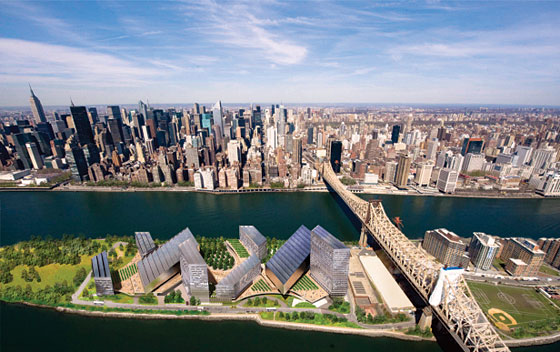
On a map, Roosevelt Island looks like it could be the city’s throbbing heart. In fact, it is a quiet high-rise village of 12,000 people in the middle of the East River, known mostly as the resting place of beer cans tossed from the Queensboro Bridge. Cornell University plans to fill in that blank in the city’s consciousness with a high-tech research center meant to attract young geniuses, seed fresh businesses, and power New York’s postindustrial intellectual economy, starting in 2017. For all that to work, Cornell’s island outpost will have to be an exciting, urban, and well-connected place.
Last week, the university signaled that its architectural ambitions match its technological ones when it selected Thom Mayne and his Los Angeles–based firm Morphosis to design the campus’s anchor building. Few recent New York commissions have had more riding on them. In Silicon Valley, engineers and entrepreneurs can huddle in anonymous warehouses, but Mayne’s structure will be as prominent on the East River’s skyline as the Pepsi-Cola sign. On a site so exposed, the home of futuristic innovation can’t look dumb and dull. It should use design to assert New York’s place as a global player in the digital economy.
The new building also shouldn’t be distant or aloof. The word isle gives us “isolation,” and the future campus is bounded by water on two sides, a park to the south, and the bridge to the north. The $100 million the Bloomberg administration has pledged to juice the project shouldn’t just turn a piece of New York over to Cornell but also help the university knit that patch of land into a crowded city. There are obstacles. Getting on and off the new campus will likely remain a chore; the small population of scientists and engineers probably won’t be numerous enough to justify a new ferry service, or even a footbridge. Mayne understands the challenges, and though he has no idea yet what form his building will take, he starts fantasizing about a building that doubles as a bridge. “You could sling a piece across the river on one side toward Manhattan,” he says, “and it would open all kinds of fantastic possibilities for linkages.” Even if that particular idea never gets farther than a paper-napkin sketch, it’s the kind of thinking Cornell needs.
Mayne has plenty of experience building for rarefied thinkers: the curvy lockbox of Cooper Union, an astrophysics building for Cal Tech, a satellite-control center in suburban Maryland, where a great steel truss, bristling with dishes, hovers over an underground office complex. He is not a delicate designer. His buildings impose themselves on the landscape, inciting more admiration than tenderness. They are as tough as the problems that people inside are trying to solve.
On Roosevelt Island, Mayne will have to summon more urban sensitivity for this assignment than he has ever shown before. In Skidmore, Owings & Merrill’s rather stolid master plan for the campus, blocky buildings are sprinkled, suburban style, across an open green. Mayne dangles the possibility that he will meddle with that scheme rather than take it as a set of givens. That’s more than a good idea; it’s an obligation. Otherwise, the university might march out of the ivory tower, only to hole up in a subsidized island redoubt.
Have good intel? Send tips to intel@nymag.com.
